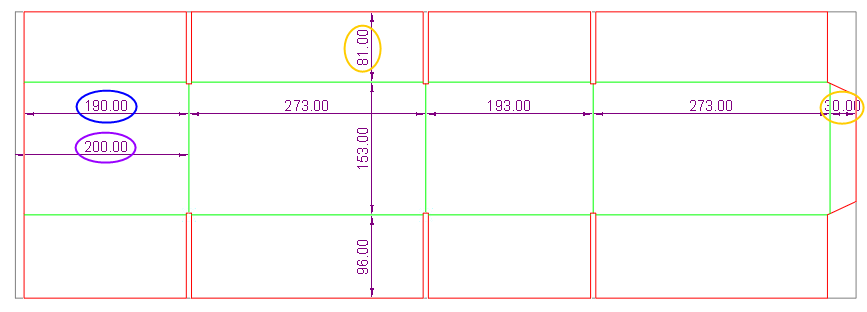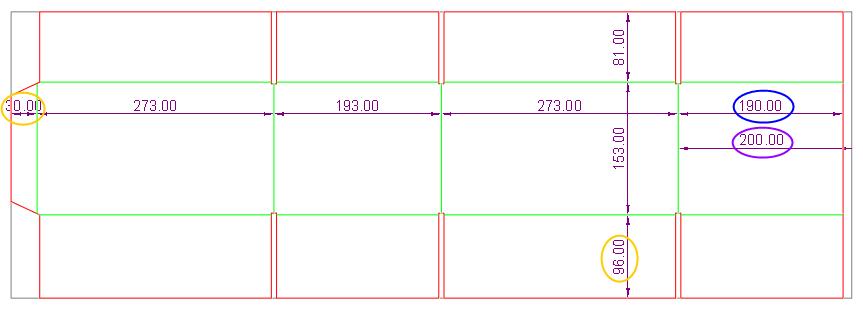Measuring tool offsets оn inliner machines
Applying the formula
The formula produces a list of values that indicate the positions
— vertical or horizontal / against or along the flute direction —
of the creasing tools оn inliner machines. The values are the distances
of the creasing tools between each other and from the sheet's edges.
The formulas count the lines according to:
- The angle at which the lines are positioned in the design.
- The style applied to them.
The formula
| Distance Type |
Direction |
Last Cut |
Sheet Edge |
Separator Type |
Use |
Result |
| Horizontal |
Left to right |
No |
Yes |
None |
$OneUp1.ToolOffsetList("Wheel Creasing",
no, yes,
90, 0, mm, n2)$ |
200.00,273.00,193.00,273.00 |
| Horizontal |
Left to right |
Yes |
No |
– |
$OneUp1.ToolOffsetList("Wheel Creasing",
yes, no,
90, 0, mm, n2L"–")$ |
190.00–273.00–193.00–273.00–30.00 |
| Vertical |
Bottom to top |
No |
Yes |
None |
$OneUp1.ToolOffsetList("Wheel Creasing",
no, yes,
180, 0, mm, n2)$ |
96.00,153 |
| Vertical |
Bottom to top |
Yes |
Yes |
/ |
$OneUp1.ToolOffsetList("Wheel Creasing",
yes, yes, 180,
0, mm, n2L"/")$ |
96.00 / 153.00 /
81.00 |
| Distance Type |
Direction |
Last Cut |
Sheet Edge |
Separator Type |
Use |
Result |
| Horizontal |
Right to left |
No |
Yes |
None |
$OneUp1.ToolOffsetList("Wheel Creasing",
no, yes, 270,
0, mm, n2)$ |
200.00,273.00,193.00,273.00 |
| Horizontal |
Right to left |
Yes |
No |
– |
$OneUp1.ToolOffsetList("Wheel Creasing",
yes, no, 270, 0, mm, n2L"–")$ |
190.00–273.00,193.00–273.00–30.00 |
| Vertical |
Top to bottom |
No |
Yes |
None |
$OneUp1.ToolOffsetList("Wheel Creasing",
no, yes, 0,
0, mm, n2)$ |
81.00,153 |
| Vertical |
Top to bottom |
Yes |
Yes |
/ |
$OneUp1.ToolOffsetList("Wheel Creasing",
yes, yes, 0,
0, mm, n2L"/")$ |
81.00 / 153.00 /
96.00 |
4. Extracting distances by taking into account the flute direction
When you need to extract distances against or along the flute direction,
use the fd() function as argument for ProductionDirection.
It returns the direction of the flute.
In the example that follows, identical formulas return different
results because they take into account the direction of the flute.
| Flute Direction |
Last Cut |
Sheet Edge |
Use |
Flute along y-axis |
Flute along x-axis |
| Against |
No |
Yes |
$OneUp1.ToolOffsetList("Wheel Creasing",
no, yes, fd(), 0, mm, n2)$ |
200.00, 273.00, 193.00, 273.00 |
81.00, 153 |
| Along |
No |
Yes |
$OneUp1.ToolOffsetList("Wheel Creasing",
no, yes, fd()+90, 0, mm,
n2)$ |
96.00, 153.00 |
200.00,273.00,193.00,273.00 |



